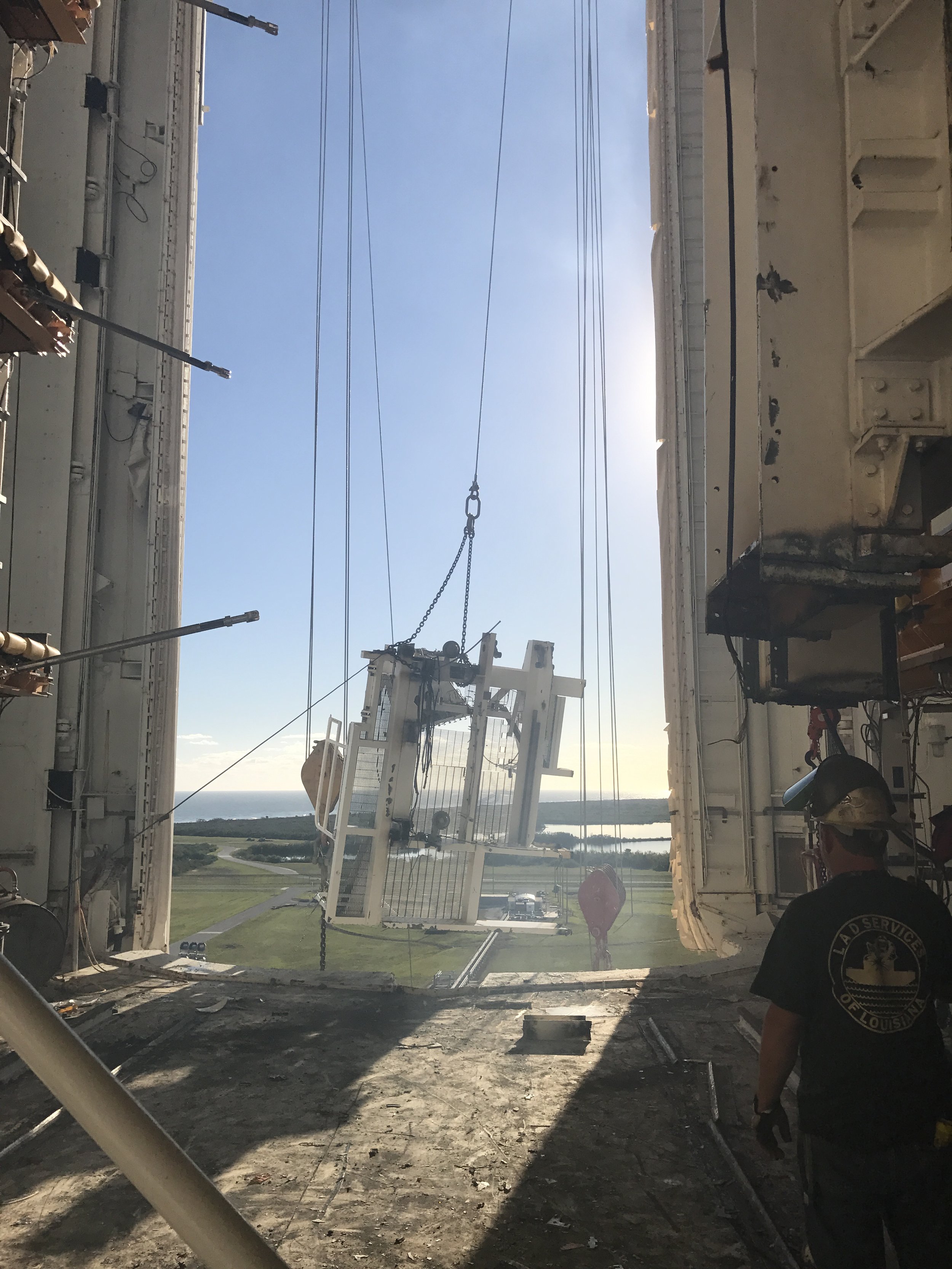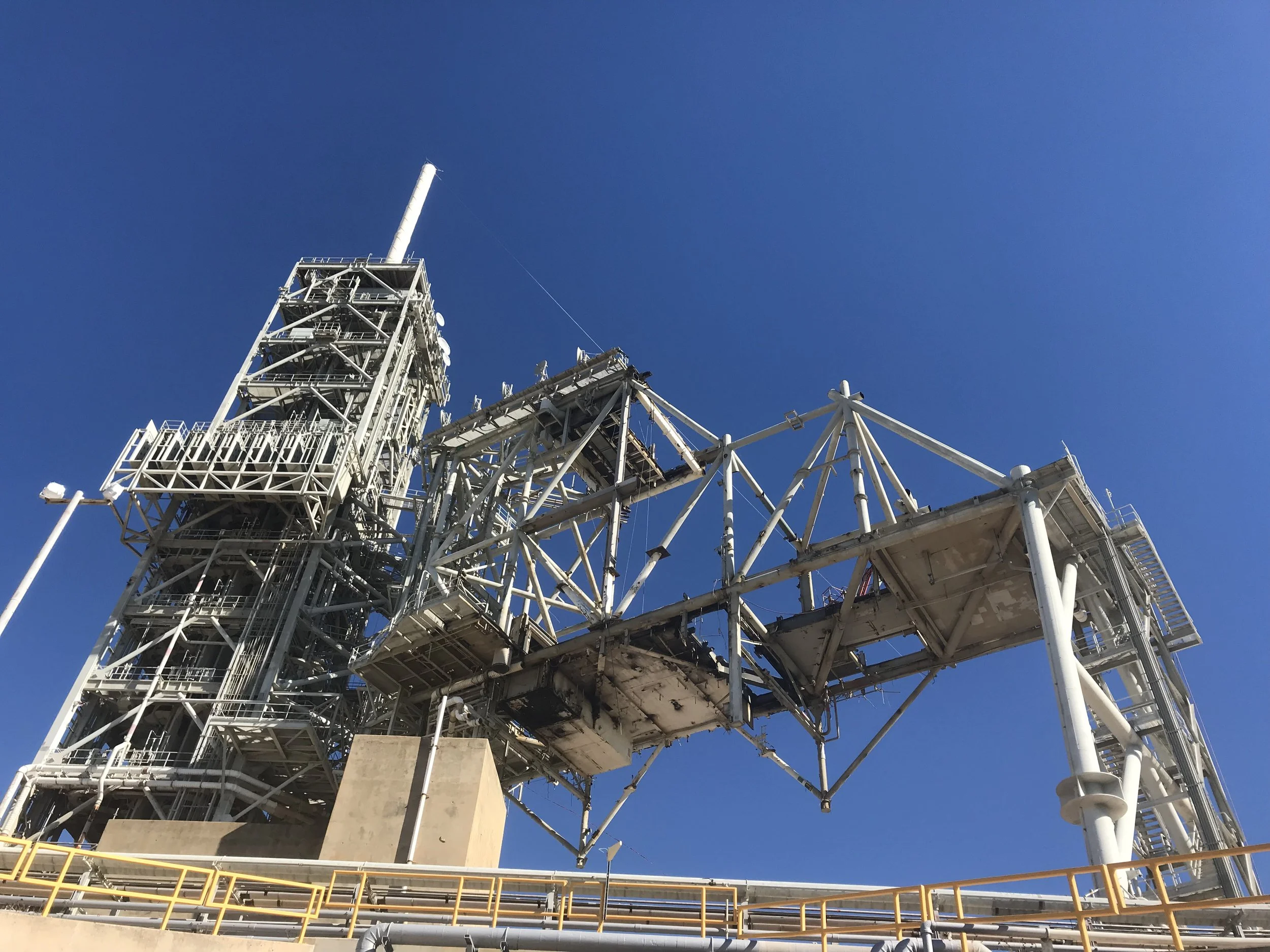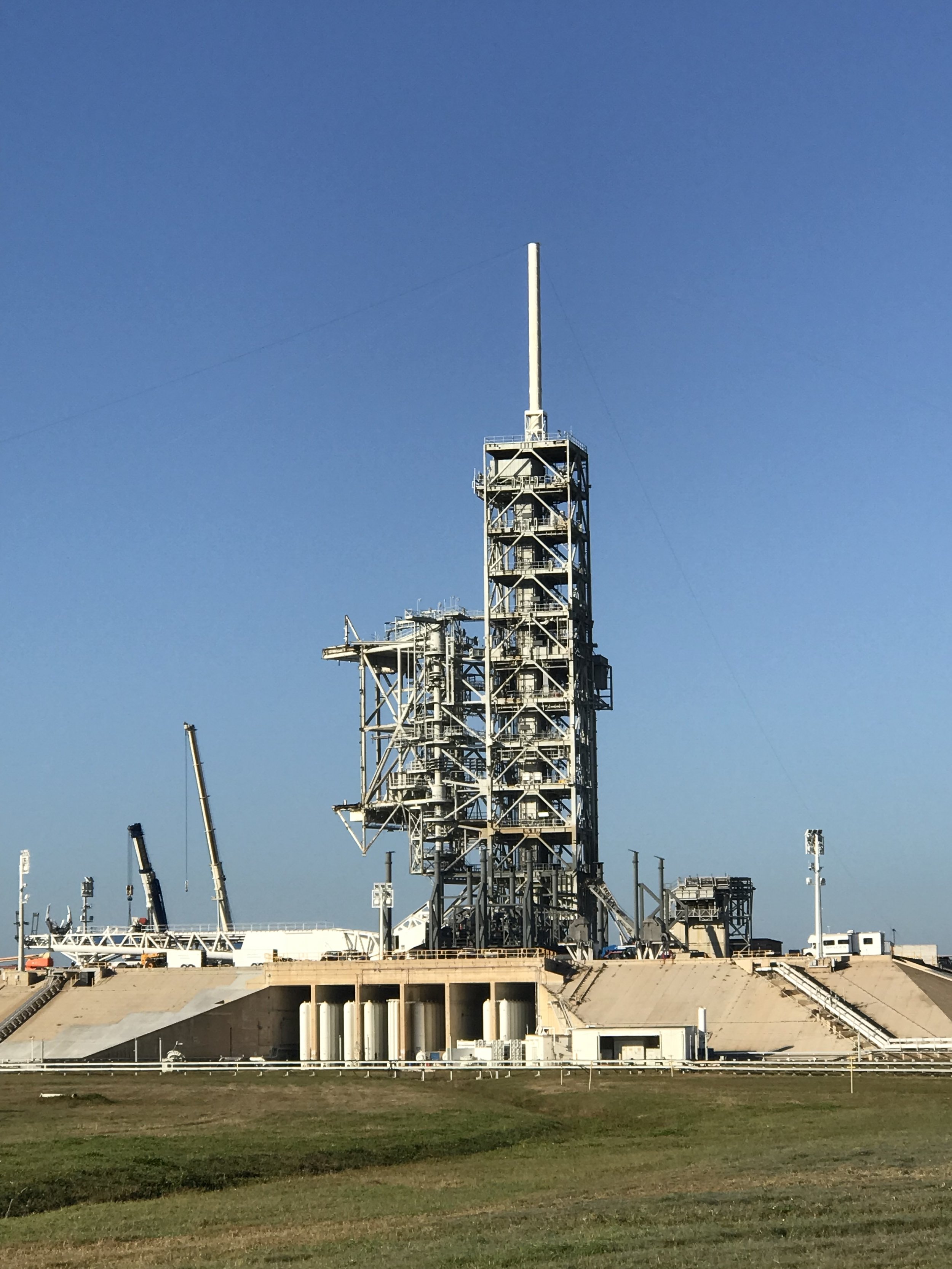Demolition of the Rotating Service Structure at LC-39A
TL;DR
After the SpaceX barge, I moved home to Alaska and started a drone service business, based on the experience I gained flying UAVs on barge missions. I quickly found myself in need of money, as the business didn’t exactly take off (pun).
Meanwhile, SpaceX had around 4 million pounds of leftover Space Shuttle tower rotting in the sea breeeze on their crown jewel launch pad at LC-39A, and they needed it gone.
I called the only person I knew crazier than me — Lee Dragna, the eponymous proprietor and motive force behind LAD Services — to see if he had any ideas. He did. A month later, we started tearing down the tower at 10% the cost of the next nearest competing bid.
How did we do it? With cables, Cajuns, and most of a plan.
Project Quote
Go ahead, light your candles, burn your incense, ring your bells, and ask God to come. But watch out — because God will come, and He will put you on His Anvil, fire up His Forge, then beat you and beat you until He turns brass into Pure Gold.
— paraphrased from Saint Keshavadas

Ghosts of the Shuttle Program
The Rotating Service Structure, or RSS, was more than just a tower. It was a massive living, breathing machine: a fully functional cleanroom that rotated its 2000+ tons on a giant hinge to encapsulate the cargo bay of a Space Shuttle on the pad. It drove along a semi-circle of rails, powered by large locomotives, and when deployed could be used to install cargo directly on the pad. It, along with its twin over on LC-39B, was an absolute workhorse in its day, but it fell into disrepair after the Space Shuttle program ended. Endless exposure to salty coastal breezes and hurricanes, without the benefit of continued maintenance, will do that. Now it was time to take it down, to make way for a new launch program.
Economics of Demolition
It’s expensive to build things, and often it’s even more expensive to take them down. Unless you’re in an area where you can use explosives to implode a structure, demolition is a slow, painstaking process (even with explosives, the cleanup is a huge job).
I was on-site working a contract on the Fixed Service Structure, the tower that still stands on LC-39A today. I kept staring at the RSS, cordoned off as unsafe to enter, and one day I idly asked what was going to happen with it. SpaceX was hustling to bring LC-39A online, both to launch the first Falcon Heavy, but also to bring all of east coast launch back online. Their other site at the Cape, LC-40, had been destroyed by an explosion during static fire and they needed to get launch capability back online ASAP.
The company had received multiple bids to demolish the tower, but they were all more than management was willing to spend. Curious, I called Lee Dragna, the owner of LAD Services in Morgan City, Louisiana. His shipyard is the place where we first outfitted the barges, and his team had come along to Florida to work the barge project with me. I asked him if he knew about the RSS and had any ideas for bringing it down in that rare combination of safely, economically, and quickly. To my surprise, he said yes.
Two Quick Phone Calls
It ends up that he, too, had been curious about tower and when he was on-site for another job, he had walked it from top to bottom one night. He pitched taking it down for a cost that was about 10% of the next nearest bid. A chill ran down my spine. Still standing in the shadow of the tower, I called my friend and mentor at SpaceX who had been promoted to VP of Launch, Recovery, and Propulsion. I gave him the rough overview and he approved the project on the call.
There was just one condition: I had to agree to manage the project. Lee had developed a reputation as ungovernable. SpaceX didn’t want to deal with this loud, opinionated, larger-than-life Cajun who repeatedly told him just what he thought about their various undertakings. The condition was fine with me. I liked and respected Lee. Plus, I hadn’t yet started The Launch Company, and my struggling drone business meant I needed whatever work I could get. I knew it would be hard work, but the job coming together at that time, and with just two quick phone calls, felt like prayers being answered.
Best Laid Plans
Long story short, the entire plan revolved around using large air-driven winches to gut the inside of the tower and pull it down to bare structure. Then, taking it down stick-by-stick until only the horizontal span between the rotating hinge and locomotives remained. A dual-crane lift would take care of that, and we’d be done. Easy. No sweat.
But reality didn’t match our conception. While we were able to make huge progress quickly, the LAD guys had a different idea of acceptable noise than the SpaceX crew. Something I didn’t anticipate was that building something on a launch site, while psychologically chaotic, is generally a clean, orderly process when it comes to actually integrating hardware. Demolition is not. Demolition is cutting metal with loud gas-powered saws, torching through tubes that sends sparks flying, and crashing materials into dumpsters positioned below the tower. We set the technicians’ (and, worse, managers’) nerves on end constantly with our buzzing, yelling, and clanging.
My job become managing the two groups, sometimes minute-by-minute. Each with humongous egos, big jobs to do, and a dislike for notes on their process. Despite rigorous lift planning, our big operations were scrutinized in a way that internal projects were not. The prospect of the tower going away at a good value had been enough to greenlight the project, but it wasn’t enough to be left alone to work. Worse, we were working on a giant tower on top of a hill. Our work progress was visible across the flat landscape for miles in all directions. Hell, we were debated and conspiratorially discussed on Reddit.
The Many Pressures Add Up
Right from the jump, there were a lot of competing pressures. Of course, there were the obvious ones like demolishing a giant tower only 80 feet from where SpaceX was hustling to bring a new launch pad online. And obviously, time pressure is table stakes for any project with this company but that was no big deal because it was a fixed-bid project so LAD was in a hurry too.
But there were funny other pressures, too. Like someone (who wasn’t me) apparently telling the SpaceX President that I would take the tower down in two months with a torch and an assistant. Look, I’m pretty damn good, but no one is that good.
There was also the concern of many of the in-house welders and technicians feeling like the LAD crew was somehow moving in on their territory. This elicited everything from passive aggression in the form of being ignored at meetings, or talked loudly about in break rooms, to the outright aggression of missing tools and sabotaged equipment. C’est la vie; haters hate up.
How It Turned Out
Despite everything, we made swift progress. We also had to demobilize and remobilize our equipment with around 24 hours of notice for launches. This also meant leaving the tower in stable configurations to absorb the launch blast pressure. This normally would have been rest time for the crew, but a major design flaw in the launch CONOPs meant that we were pressed into service during launch campaigns as well. Let’s just say, the parlance of business, that SpaceX had a go-to-market problem and I figured out a way to solve it with the demolition crew. This took a lot of the pressure off of us, and ingratiated us (albeit begrudgingly) with most of the SpaceX crew.
During this time, I was flying back and forth between Alaska and Florida biweekly, on average. We finally found our stride and were able to make huge amounts of progress between campaigns. Bit by bit, the tower disappeared. I noticed on my drive in each morning that it stopped appearing above the mangrove at the usual turn in the road. We brought the cranes in and took down the exoskeleton superstructure. Then, a few weeks later, took down the horizontal span.
We didn’t quite make the aggressive 12-month schedule, but we came in on budget and left the site in spring of 2018. It was sad to have the project come to a close, but in the background I’d given up on the drone company and had started something new, helping other space companies with their big challenges.
This is one of the big locomotives that pulled the 4,000-ton tower around on its big semi-circular track.
We gutted the insides of the tower using winch cables run through pulleys hung throughout. Then as we demo'd everything inside, we just pulled it out the front door.
It didn't always fit the first try.
This was no empty tower. This was an intricate machine with foam panel walls and a full cleanroom inside.
Many structures hung off the bottom of the tower's cross-span. These were cutoff wholesale ...
... then lowered as one massive piece to the ground.
Lowering whole sections like these, to be further processed on the ground, was a real time saver.
It thinned out quickly, but this was the hardest part of the job.
The demo crew got the tower down to bare structure in no time.
Our work was not without it's pressures. Literally, we worried about thrust pressure on the tower and always had to leave it in a stable state pre-launch.
Removing the overhung crane structure with the giant block, winches, and motors was a huge challenge.
The floor started coming down, which meant the end of working from inside the tower.
The pipes look a lot bigger up close on the ground.
The last piece holding the two sides of the tower together is removed.
Which means these giants can lie down to rest.
After the end of a long push working day and night shifts, the remainder of the job hangs cantilevered.
One of these days I gotta tell *this* story.
Bit we bit we pulled it back to it's neighbor, the Fixed Service Structure. This tower was retrofitted and now transports astronauts to the crew arm and into Dragon.

























